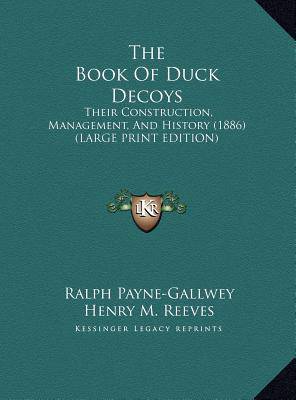
- Afhalen na 1 uur in een winkel met voorraad
- Gratis thuislevering in België vanaf € 30
- Ruim aanbod met 7 miljoen producten
- Afhalen na 1 uur in een winkel met voorraad
- Gratis thuislevering in België vanaf € 30
- Ruim aanbod met 7 miljoen producten
Zoeken
The Book Of Duck Decoys
Their Construction, Management, And History (1886) (LARGE PRINT EDITION)
Ralph Payne-Gallwey
Hardcover | Engels
€ 59,95
+ 119 punten
Uitvoering
Omschrijving
The Book of Duck Decoys: Their Construction, Management, and History is a comprehensive guide to the design and use of duck decoys. Originally published in 1886, this book is a valuable resource for hunters, collectors, and anyone interested in the history of waterfowl hunting. The author, Ralph Payne-Gallwey, provides detailed instructions on how to build and maintain duck decoys, including information on the various materials and tools needed for construction. He also offers advice on decoy placement and management strategies, as well as insights into the history and cultural significance of these hunting tools. This large print edition is perfect for readers who prefer larger text or who may have difficulty reading smaller print. Overall, The Book of Duck Decoys is a fascinating and informative read for anyone interested in the art and science of waterfowl hunting.(LARGE PRINT EDITION) Sir Ralph Frankland-Payne-Gallwey, 3rd Baronet, was one of numerous accomplished English gentlemen of the Victorian era. He, the third of six Yorkshire baronets holding the name Payne-Gallwey, was born on August 19, 1848, and died on November 24, 1916. He was educated at Eton, married Edith Alice Usborne in 1877, and was Magistrate for North Riding, Yorkshire. The couple had five children, of which their only son was killed in action in World War I. Payne-Gallwey was an extraordinarily talented engineer, historian, ballistics expert, artist, and sport hunter. These abilities are amply reflected in several books, some of which are considered to be among the most definitive of their subjects. Among the most notable are: The Fowler in Ireland ������� (1882); Shooting, Field and Covert ������� 2 vols. (1887), co-authored with Lord Walsingham; The Crossbow ������� (1903); Introduction to The Diary of Col. Peter Hawker, 1802-1853. 1903; The Projectile Throwing Machines of the Ancients ������� (1907); and Shooting High Pheasants ������� (1913).The present book, The Book of Duck Decoys ������� (1886), is clearly the most authoritative work on that subject.--Henry M. Reeves.This scarce antiquarian book is a facsimile reprint of the old original and may contain some imperfections such as library marks and notations. Because we believe this work is culturally important, we have made it available as part of our commitment for protecting, preserving, and promoting the world's literature in affordable, high quality, modern editions, that are true to their original work.
Specificaties
Betrokkenen
- Auteur(s):
- Uitgeverij:
Inhoud
- Aantal bladzijden:
- 256
- Taal:
- Engels
Eigenschappen
- Productcode (EAN):
- 9781169966475
- Verschijningsdatum:
- 1/02/2011
- Uitvoering:
- Hardcover
- Formaat:
- Genaaid
- Afmetingen:
- 216 mm x 279 mm
- Gewicht:
- 884 g

Alleen bij Standaard Boekhandel
+ 119 punten op je klantenkaart van Standaard Boekhandel
Beoordelingen
We publiceren alleen reviews die voldoen aan de voorwaarden voor reviews. Bekijk onze voorwaarden voor reviews.











